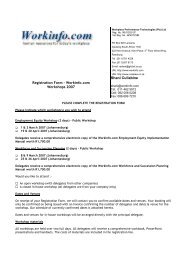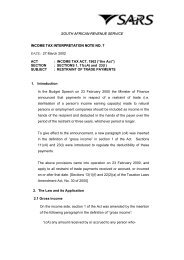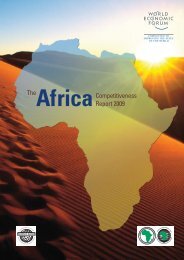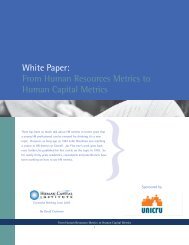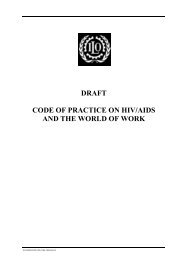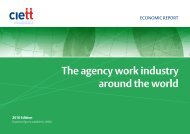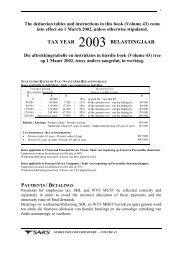The CEO's role in talent management - DDI
The CEO's role in talent management - DDI
The CEO's role in talent management - DDI
You also want an ePaper? Increase the reach of your titles
YUMPU automatically turns print PDFs into web optimized ePapers that Google loves.
PROFILES<br />
<strong>The</strong> CEO’s <strong>role</strong> <strong>in</strong> <strong>talent</strong> <strong>management</strong><br />
How top executives from ten countries are nurtur<strong>in</strong>g the leaders of tomorrow<br />
Executive: Michael Critelli<br />
Title: Chief Executive Officer<br />
Company: Pitney Bowes Inc.<br />
Location: Stamford, Connecticut<br />
CEO s<strong>in</strong>ce: 1994<br />
Age: 57<br />
Previous position: Vice-chairman<br />
Sector: Mail<strong>in</strong>g, shipp<strong>in</strong>g and weigh<strong>in</strong>g systems<br />
Revenue (2005): US$5.5bn<br />
It pays to develop subord<strong>in</strong>ates at Pitney<br />
Bowes. <strong>The</strong> almost century-old provider of<br />
mail<strong>in</strong>g, shipp<strong>in</strong>g and weigh<strong>in</strong>g systems bases<br />
its executives’ bonuses partly on their ability to<br />
ready successors for key jobs, says its CEO,<br />
Michael Critelli.<br />
Mr Critelli believes that strong succession is<br />
a sign of stability, which is vital for long-term<br />
growth. In its succession scheme, Pitney<br />
Bowes has at least two people <strong>in</strong> l<strong>in</strong>e for most<br />
positions, <strong>in</strong>clud<strong>in</strong>g 10-15 potential candidates<br />
for CEO and other senior positions. Pitney<br />
Bowes’ revenue grew 11% last year to<br />
US$5.5bn.<br />
Pitney Bowes knows who would replace Mr<br />
Critelli or the company’s most senior executives<br />
<strong>in</strong> an unexpected situation. <strong>The</strong> company also<br />
has succession plans that look three, five and<br />
ten years out. Mr Critelli plays the lead <strong>role</strong> <strong>in</strong><br />
updat<strong>in</strong>g these plans <strong>in</strong> consultation with his<br />
<strong>in</strong>ner circle and the board. “I do a fairly detailed<br />
analysis of senior managers that I share with the<br />
senior team and with the board,” he expla<strong>in</strong>s. “I<br />
derive from that what I th<strong>in</strong>k are the musthaves—the<br />
core competencies that an<br />
<strong>in</strong>dividual needs to have to be the CEO <strong>in</strong> that<br />
environment. <strong>The</strong>n I go through a process with<br />
my senior team and with the board of evaluat<strong>in</strong>g<br />
a core group of executives aga<strong>in</strong>st those<br />
competencies and talk to them about<br />
development action that we’re go<strong>in</strong>g to take to<br />
have ready successors—short-term, mediumterm,<br />
long-term because I’m look<strong>in</strong>g at four<br />
dimensions relative to CEO succession. <strong>The</strong><br />
number one succession time frame is: ‘What<br />
would happen if I were hit by a bus tomorrow’<br />
I’ve got to file with the governance committee,<br />
chair of the board and the presid<strong>in</strong>g director of<br />
the board my recommendations as to what the<br />
board should do if that were to happen. I then<br />
look out three to five years, five to seven years<br />
and then eight to ten years.”<br />
He adds: “I look at different potential leaders<br />
for each of those timeframes. It helps us to see<br />
where we need to shore up our <strong>talent</strong> and where<br />
we th<strong>in</strong>k we’re <strong>in</strong> good shape, and it also<br />
creates a sense of urgency to make<br />
developmental moves. Very often what we f<strong>in</strong>d<br />
is that we will go to an <strong>in</strong>dividual and they’ll say,<br />
‘I’ve got children <strong>in</strong> high school. I really don’t<br />
want to relocate until 2007,’ and we say ‘Can<br />
you accommodate an earlier move to position<br />
yourself to take advantage of more career<br />
options’”<br />
Mr Critelli says his group reviews<br />
productivity and such areas as customer loyalty.<br />
But it also weighs executives’ performance on<br />
annual employee evaluations. <strong>The</strong>re is a key<br />
element <strong>in</strong> these appraisals, which <strong>in</strong>corporate<br />
scor<strong>in</strong>g and written segments: Is the executive<br />
help<strong>in</strong>g people to develop the skills they need to<br />
advance their careers<br />
<strong>The</strong> annual assessments are part of a<br />
meticulous, ongo<strong>in</strong>g process. Mr Critelli<br />
estimates that he spends about 25% of his time<br />
on <strong>talent</strong> <strong>management</strong>. He discusses leadership<br />
regularly with his senior <strong>management</strong> team,<br />
called the Enterprise Leadership Council. He<br />
covers leadership and succession along with<br />
other issues at skip-level meet<strong>in</strong>gs, so-called<br />
because they <strong>in</strong>volve about 200 executives<br />
more than one level below. Mr Critelli conducts<br />
150-160 of these meet<strong>in</strong>gs annually. He also<br />
holds a set of about eight meet<strong>in</strong>gs with<br />
“emerg<strong>in</strong>g strategic leaders”, <strong>in</strong>dividuals who<br />
are between 25 and 35 years old and who Mr<br />
Critelli wants to know better. “<strong>The</strong>re are th<strong>in</strong>gs<br />
that I am do<strong>in</strong>g dur<strong>in</strong>g the course of skip-level<br />
meet<strong>in</strong>gs that don’t <strong>in</strong>volve leadership<br />
development,” Mr. Critelli says. <strong>The</strong>re’s a lot of<br />
give and take. He adds: “I am communicat<strong>in</strong>g<br />
operational <strong>in</strong>sights, I am gett<strong>in</strong>g people to<br />
understand my th<strong>in</strong>k<strong>in</strong>g, but I am also evaluat<strong>in</strong>g<br />
the people with which I am talk<strong>in</strong>g.”<br />
Pitney Bowes has a number of development<br />
programmes for people at all levels. <strong>The</strong><br />
company offers week-long retreats on<br />
leadership for vice-presidents and above.<br />
Executives may attend three of these events<br />
over 18 months. Among other topics, they cover<br />
personnel and leadership issues. Mr Critelli<br />
addresses these groups about once every six<br />
weeks. “I give people the benefit of my<br />
experience and hold Q&A sessions with them.”<br />
Mr Critelli sees no one position as a<br />
particularly likely spr<strong>in</strong>gboard to his job. His two<br />
predecessors came from f<strong>in</strong>ancial and<br />
market<strong>in</strong>g backgrounds. His current COO started<br />
<strong>in</strong> sales. One of his unit presidents was an<br />
eng<strong>in</strong>eer. “<strong>The</strong>re was not a s<strong>in</strong>gle historical<br />
pattern,” he says. “We have diverse leadership.”<br />
But Mr Critelli believes that executives learn<br />
their most valuable lessons through experience.<br />
Pitney Bowes encourages key managers to<br />
serve on boards and to accept assignments—<br />
jobs or projects—outside their expertise. “If<br />
somebody is <strong>in</strong> a job <strong>in</strong> which they are used to<br />
manag<strong>in</strong>g people that are close to them, you<br />
give them a remote <strong>management</strong> assignment or<br />
you <strong>in</strong>crease the size of the bus<strong>in</strong>ess that they<br />
run or you give them a bus<strong>in</strong>ess with multiple<br />
functions,” he says, add<strong>in</strong>g: “<strong>The</strong>re are task<br />
forces or work<strong>in</strong>g groups over which you might<br />
put someone <strong>in</strong> charge. I have a crisis<br />
<strong>management</strong> and emergency team that deals<br />
with challenges like a response to Hurricane<br />
Katr<strong>in</strong>a or the New York City transit strike or the<br />
tsunami. We will put someone <strong>in</strong> charge of that<br />
team for a year to 18 months.”<br />
Mr Critelli was the firm’s chief legal council<br />
for years before becom<strong>in</strong>g CEO. He says that he<br />
probably would have been better off at the<br />
outset with experience runn<strong>in</strong>g bus<strong>in</strong>ess<br />
divisions. A one-time rival for the CEO job helped<br />
him to shore up his weaknesses before the<br />
executive left the company. “I had run staff<br />
functions and been very effective but it’s a<br />
different environment go<strong>in</strong>g from runn<strong>in</strong>g staff<br />
functions to runn<strong>in</strong>g multiple l<strong>in</strong>es of bus<strong>in</strong>ess. I<br />
never really had the apprenticeship of runn<strong>in</strong>g a<br />
sales organization, a factory or an operations<br />
function like a call center. I didn’t have the<br />
nuances down when I took this job and I had to<br />
learn on the job,” Mr. Critelli says. “I had the<br />
help of a capable COO when I started, but he<br />
aspired to be a CEO somewhere else, which he<br />
ultimately did. But it would have been better,<br />
probably for both of us, if he became a CEO<br />
somewhere else earlier because I was fully<br />
qualified to take on the CEO job without a COO<br />
earlier than we actually made the transition.”<br />
Mr Critelli believes that executive coach<strong>in</strong>g<br />
is helpful over limited periods and <strong>in</strong> address<strong>in</strong>g<br />
specific issues. “It’s like psychiatry; sometimes<br />
people develop a co-dependency relationship<br />
and I th<strong>in</strong>k it’s good that executive coaches do<br />
32 © <strong>The</strong> Economist Intelligence Unit 2006






